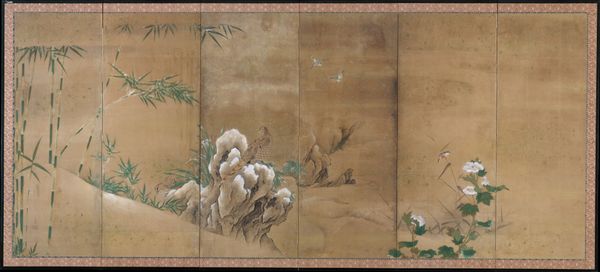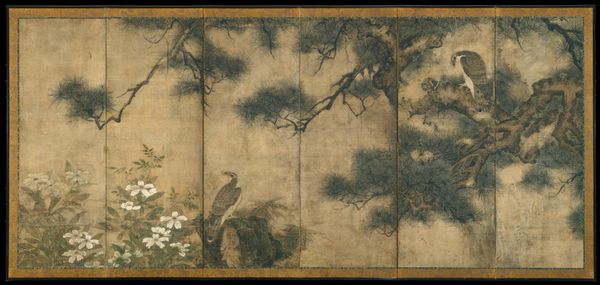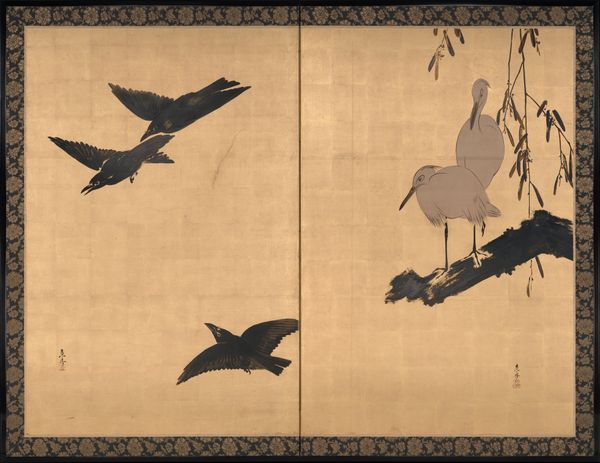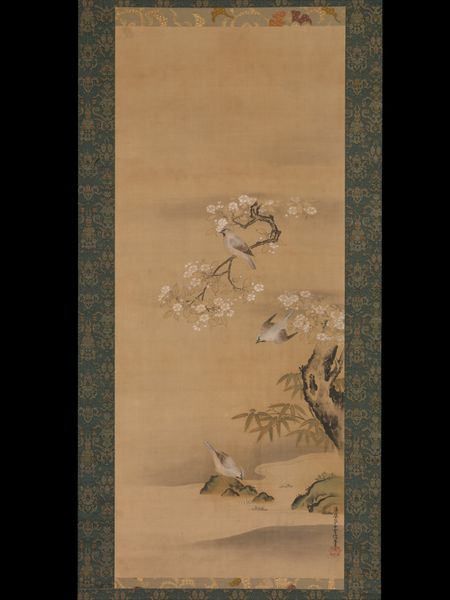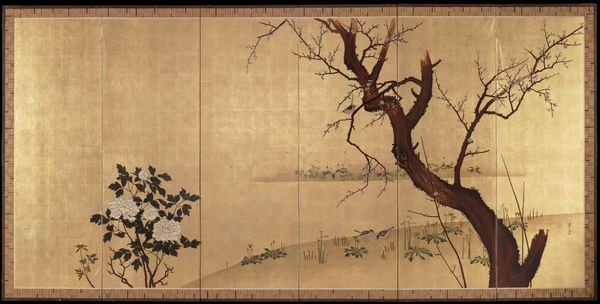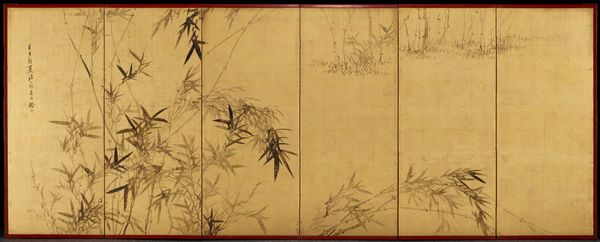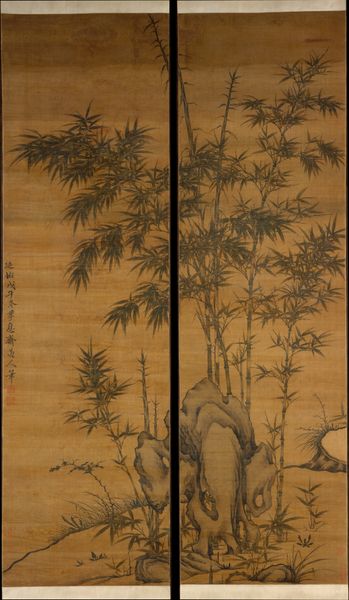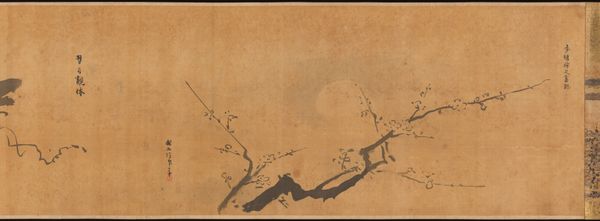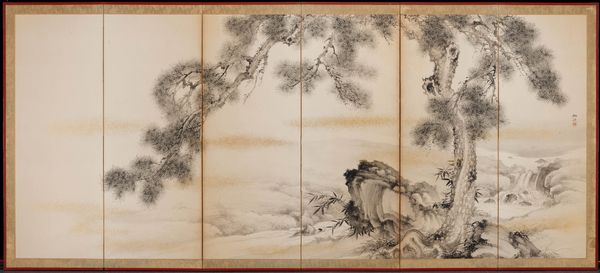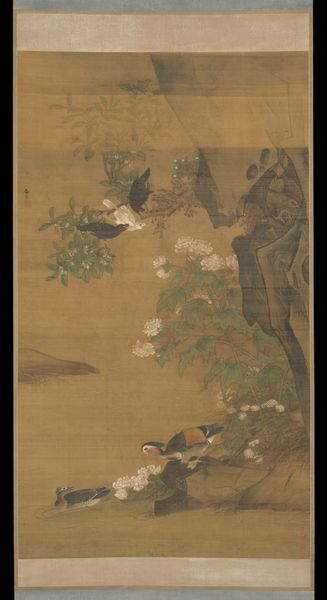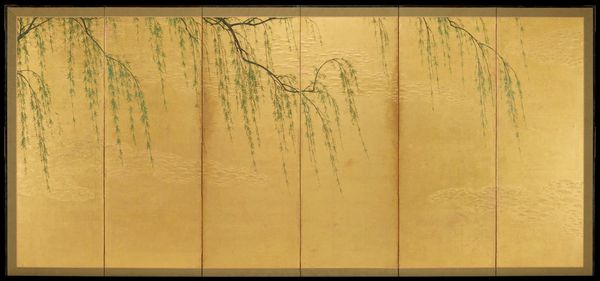![Birds in Landscape [left of a pair] by Kano Naonobu](/_next/image?url=https%3A%2F%2Fd2w8kbdekdi1gv.cloudfront.net%2FeyJidWNrZXQiOiAiYXJ0ZXJhLWltYWdlcy1idWNrZXQiLCAia2V5IjogImFydHdvcmtzL2Y4ZDQ0NDU5LWMyNzUtNDY4My1iMGQ3LTYyNWY4NzE3MWJjOS9mOGQ0NDQ1OS1jMjc1LTQ2ODMtYjBkNy02MjVmODcxNzFiYzlfZnVsbC5qcGciLCAiZWRpdHMiOiB7InJlc2l6ZSI6IHsid2lkdGgiOiAxOTIwLCAiaGVpZ2h0IjogMTkyMCwgImZpdCI6ICJpbnNpZGUifX19&w=3840&q=75)
painting, watercolor, ink
#
water colours
#
ink painting
#
painting
#
asian-art
#
landscape
#
japan
#
watercolor
#
ink
#
orientalism
#
watercolor
Dimensions: 58 1/2 × 144 in. (148.59 × 365.76 cm) (image)66 1/8 × 151 3/8 × 5/8 in. (167.96 × 384.49 × 1.59 cm) (mount)
Copyright: Public Domain
Curator: Isn't this such a tranquil piece? I feel a hush just looking at it. Editor: It does evoke stillness. What we're seeing here is "Birds in Landscape," a section of a painted screen, likely ink and watercolors on paper, created around the 17th century by Kano Naonobu. It resides here at the Minneapolis Institute of Art. My first thought is about representation; the quietude for some perhaps reflects not so much peace, but silencing and oppression, given what the Tokugawa Shogunate was enacting in Japan at the time. Curator: Silencing—oppression—oh, heavy. I see what you're getting at. It's good to hold space for that reading, certainly. But what catches my eye, initially, are the birds themselves. The delicacy, how each is unique and captured so precisely. The painter isn't just recording nature; he’s conversing with it. I find it intimate. Editor: Indeed, they’re more than decoration, for sure. Consider, too, how "nature" itself has been historically used. Who gets access to its restorative power, and who is forced to interact with it only as a site of labor or resource extraction? Even a painting like this participates in that story, subtly defining whose perspective matters. But I agree with your comments regarding the artistry here. These types of natural works were definitely favored during the Edo period. Curator: Do you find something insidious there, then? The celebration of nature… almost as a distraction? Editor: Perhaps a strategic harmony is more accurate than just “distraction." You mentioned that this type of painting feels intimate, right? That sensibility extends beyond mere aesthetics, touching upon the complicated power relations of its historical moment. I want the listener to remember the context that produced this. Curator: All good food for thought, as always. It is lovely, though—to lose oneself, if only for a moment, in Naonobu’s gentle world, as carefully constructed and complicated as that world was. Editor: Exactly, and as such it reminds us to be mindful in our observations as well, now more than ever. Art becomes the invitation.
Comments
minneapolisinstituteofart almost 2 years ago
⋮
Although these paintings now exist as a pair of folding screens, this is not how Kano Naonobu designed them. He originally designed them as sliding wall panels. One of the ways you can tell is by looking closely at the far left panel of the right screen, where at the left edge you can see a telltale round repair in the paper surface. This was where one of the door pulls originally was. In that original format—essentially movable, floor-to-ceiling murals—they would have surrounded the room’s occupants, giving them the sense of being immersed in nature.
Join the conversation
Join millions of artists and users on Artera today and experience the ultimate creative platform.
